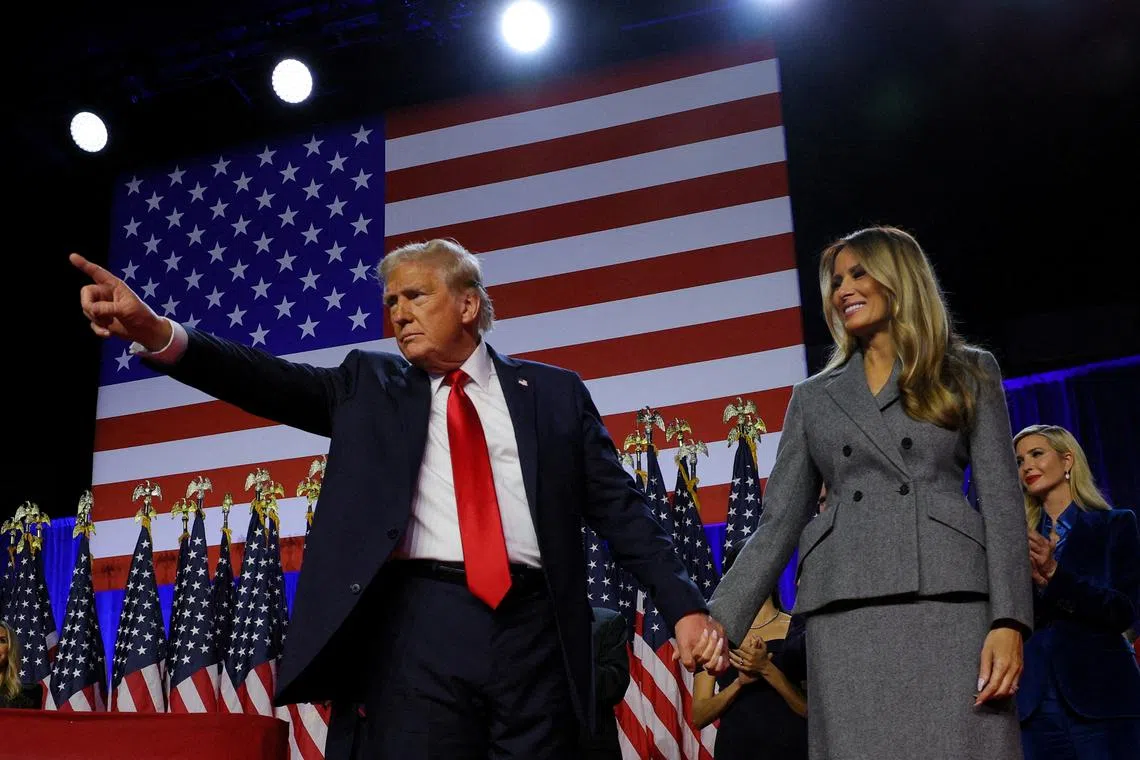Impact of Trump’s inflationary economic plan uncertain until he makes his first move
Sign up now: Get ST's newsletters delivered to your inbox

US President-elect Donald Trump has pledged to cut taxes, unwind regulations on energy and finance, and impose harsh tariffs on trade partners.
PHOTO: REUTERS
Follow topic:
SINGAPORE – Expect interest rates to remain high and the Singapore dollar and other Asian currencies to ease as US President-elect Donald Trump starts to bring his inflationary economic agenda into reality.
However, the true extent of the impact these policies will have can be assessed only when he turns his campaign trail promises into law after he takes office on Jan 20, analysts said.
His pledges to cut taxes, unwind regulations on energy and finance, and impose harsh tariffs on trade partners have increased concerns that the US government will be looking to raise more debt to finance these moves.
While hopes that lower taxes and deregulation will result in stronger growth boosted the S&P 500 index on Wall Street to a record overnight, the US bond market virtually tanked.
The yield on 10-year US Treasury bonds rose to 4.4 per cent on Nov 6, up from the year’s low of 3.6 per cent in September.
Analysts said the bond market is pricing in a scenario where higher debt and deficits, in combination with a pickup in growth, may reignite inflation.
Mr Eric Robertsen, global head of research and chief strategist at Standard Chartered Bank, said: “Trump is expected to pursue loose fiscal policy; this, combined with his pledge to raise tariffs, has raised fears that US inflation may resume its upward trend.”
He said resurgent US growth and inflation would likely push the Federal Reserve to keep its benchmark rates higher than earlier expected through 2025. The Fed may give some clues about its views on Nov 7, when it announces its latest rate decision.
The outlook for higher interest rates also boosted the US dollar against other currencies.
The Singapore dollar traded at 1.33 to the US dollar,
In about the same period, the Malaysian ringgit dropped 6.8 per cent, while the Indonesian rupiah was off by almost 5 per cent.
Citibank analysts expect the US dollar to rally 3 per cent over the next 12 months against an index of 10 major currencies such as the euro, Japanese yen and British pound.
With currencies facing depreciation pressure, central banks in Asia will see less room for rate cuts, analysts said.
Relatively higher interest rates than earlier expected would set the stage for a weaker economic growth outlook.
“In the coming days, we will see more (market) pricing towards a world characterised by higher US tariffs and other protectionist measures, a wider range of pressures on China and on those who do business with China,” said DBS Bank chief economist Taimur Baig.
“Coming into this election, the odds were even, so the outcome is not shocking. But given that it is Trump, there is an element of heightened concern in Asia,” he noted.
Still, some analysts believe that Trump’s pledges cannot be taken at face value.
Mr Alvin Liew, senior economist at UOB Group, said Trump’s victory speech on Nov 6
“While it could be accidental for him to forget to mention tariffs, it could also be that this is not on the top of his to-do list for now,” he added.
Mr Liew said Trump may initially focus on the areas of taxes, the military, foreign policy, border security and energy policies.
“The tariff threat may likely be used first as a bargaining chip to gain concessions from China and other key trade partners, rather than being laid out as an immediate policy to be enacted into law,” he noted.
Mr Barnabas Gan, RHB Bank’s acting group chief economist and head of market research, said Trump’s protectionist policies and their negative impact on China and Asean will likely be at the forefront of investors’ concerns.
“However, it is too early to call a sizeable downturn,” he noted. “Short-term global economic volatility – should it materialise – will likely be insufficient to dent the remarkably resilient global economic growth trend.”
Mr Baig said tariffs are an “unambiguous negative” for Asia, but the region’s strong ties with the US and China would survive Trump.
“Exports will face more scrutiny, there will be more regulatory headaches. But the region’s scale, excellence in manufacturing and logistics, strong corporate and public sector balance sheets will hold it in good stead during Trump 2.0,” he noted.
An International Monetary Fund report in October warned that a tit-for-tat 10 percentage point increase in tariffs by the three major economies – the US, China and the euro zone – by mid-2025 would cut global economic output by 0.8 per cent in 2025 and 1.3 per cent in 2026.
There are no detailed estimates on the impact Trump’s tariffs would have on the Singapore economy, which barely grew 1.3 per cent in 2019, the slowest pace in a decade, after the onset of the US-China trade war in 2018.


